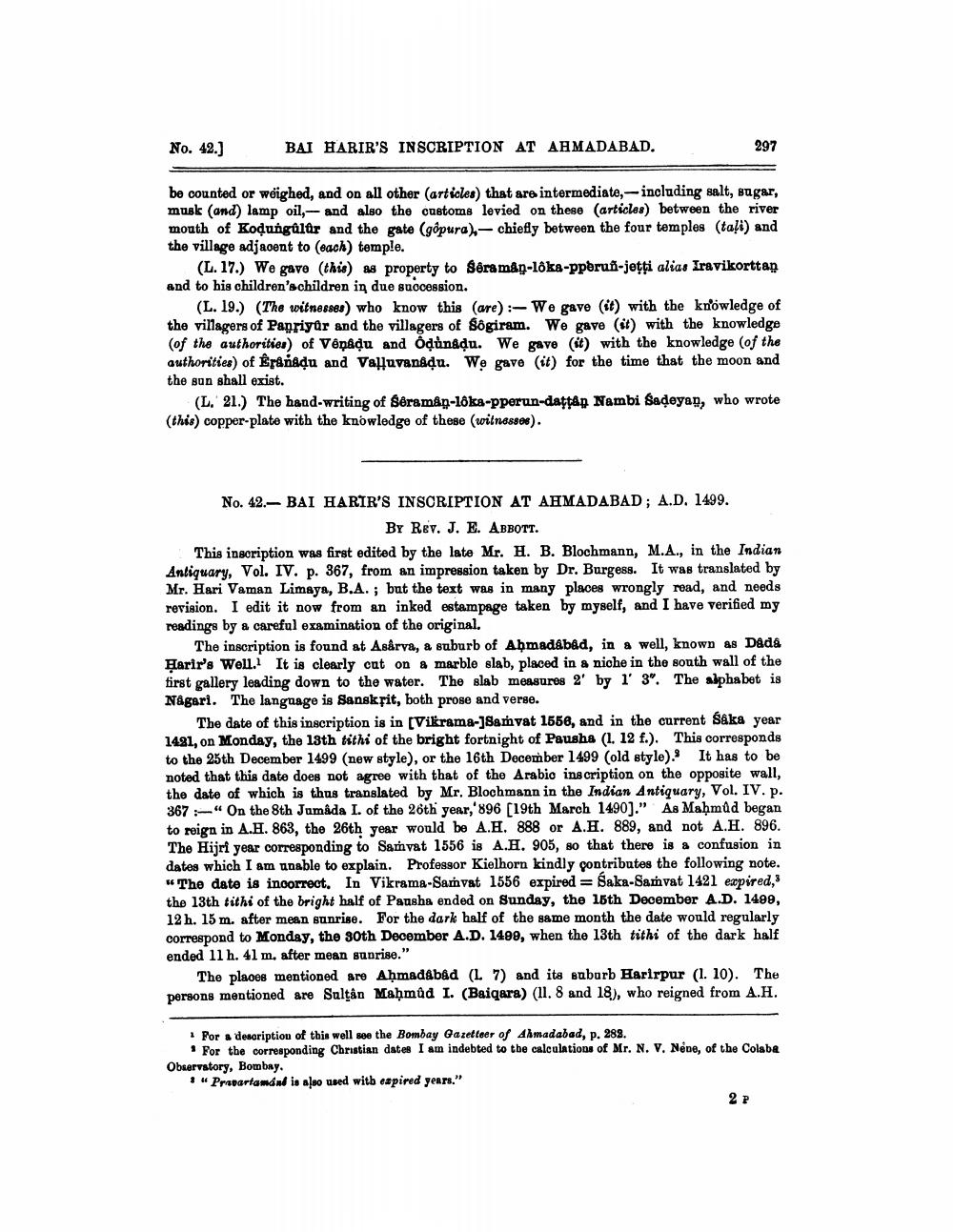________________
No. 42.)
BAI HARIR'S INSCRIPTION AT AHMADABAD.
297
be counted or weighed, and on all other (articles) that are intermediate,- including salt, sugar, musk (and) lamp oil, and also the customs levied on these (articles) between the river mouth of Kodungular and the gate (gópura)-chiefly between the four temples (taļi) and the village adjacent to each) temple.
(L. 17.) We gave (this) as property to Sêra mån-lôka-pperuň-jețţi alias Iravikorttan and to his children's children in due succession.
(L. 19.) (The witnesses) who know this (are) :-- We gave (it) with the knowledge of the villagers of Papriyar and the villagers of Sôgiram. We gave (it) with the knowledge (of the authorities of Vênádu and Ôđànqu. We gave (it) with the knowledge (of the authorities) of Êrånadu and Valluvanadu. We gave (it) for the time that the moon and the sun shall exist.
(L. 21.) The hand-writing of Sêraman-lôka-pperun-dattåp Nambi Sadeyan, who wrote (this) copper-plate with the knowledge of these (witnesses).
No. 42.- BAI HARTR'S INSCRIPTION AT AHMADABAD; A.D. 1499.
By Rev. J. E. ABBOTT. This inscription was first edited by the late Mr. H. B. Blochmann, M.A., in the Indian Antiquary, Vol. IV. p. 367, from an impression taken by Dr. Burgess. It was translated by Mr. Hari Vaman Limaya, B.A.; but the text was in many places wrongly read, and needs revision. I edit it now from an inked estampage taken by myself, and I have verified my readings by a careful examination of the original.
The inscription is found at Asarva, a suburb of Ahmadabad, in a well, known as Dada Harir's Well. It is clearly cut on & marble slab, placed in a niche in the south wall of the first gallery leading down to the water. The slab measures 2' by 1' 3". The alphabet is Nagari. The language is Sanskrit, both prose and verse.
The date of this inscription is in [Vikrama-]8amvat 1558, and in the current Saka year 1481, on Monday, the 13th tithi of the bright fortnight of Pausha (1. 12 f.). This corresponds to the 25th December 1499 (new style), or the 16th December 1499 (old style). It has to be noted that this date does not agree with that of the Arabio inscription on the opposite wall, the date of which is thus translated by Mr. Blochmann in the Indian Antiquary, Vol. IV. p. 367 “On the 8th Jumada L. of the 26th year,'896 [19th March 1490)." As Mahmûd began to reign in A.H. 863, the 26th year would be A.H. 888 or A.H. 889, and not A.H. 896. The Hijri year corresponding to Samvat 1556 is A.H. 905, so that there is a confusion in dates which I am unable to explain. Professor Kielhorn kindly contributes the following note. "The date is incorrect. In Vikrama-Samvat 1556 expired = Saka-Samvat 1421 expired, the 13th tithi of the bright half of Paasha ended on Sunday, the 15th December A.D. 1499, 12 h. 15 m. after mean sunrise. For the dark half of the same month the date would regularly correspond to Monday, the 30th December A.D. 1499, when the 13th tithi of the dark half ended 11 h. 41 m. after mean suprise."
The places mentioned are Aḥmadabad (L 7) and its suburb Harirpur (1. 10). The persons mentioned are Sultan Mahmud I. (Baiqara) (11. 8 and 18), who reigned from A.H.
For a description of this well soe the Bombay Gazetteer of Ahmadabad, p. 289.
. For the corresponding Christian dates I am indebted to the calculations of Mr. N. V. Neve, of the Colabe Observatory, Bombay,
+ "Prapartamánd is also used witb expired years."




